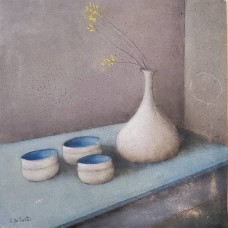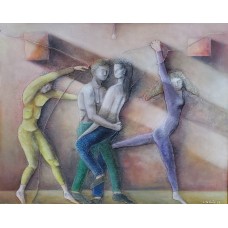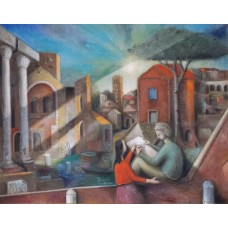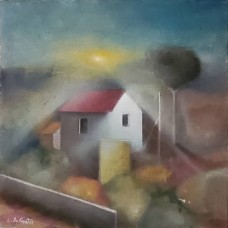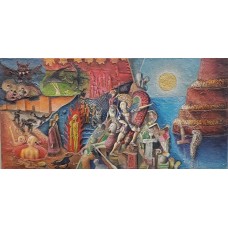De Curtis
Alfredo DeCurtis' captivating works ignite an exquisite softness towards their subjects, which the artist introduces through an innovative approach to his medium. He incorporates sand with oil paint to create an overwhelmingly solicitous aura in his oeuvre. His unique style also unmistakably reveals the indelible influence of his Italian heritage with discernible references to classical fresco painting and Renaissance tableaux, while simultaneous references to the Impressionists can also be inferred; most notably, through the acute academic thought shared with Paul Cezanne. An adventurous side to this creative soul is evident when considering his extensions of line and perspective, which suggest inspiration taken from Wassily Kandinsky and the surrealism of Salvador Dali. Deftly navigating through this ubiquitous array of artistic inspiration, De Curtis paints figures, landscapes, and still lifes with ceaseless delicacy and tenderness. The natural mediums he utilizes create a richly textured surface upon which to layer oil paint, forming an organic atmosphere that evokes a profoundly peaceful aura. De Curtis’ masterful use of chiaroscuro allows the subjects of each piece to exude a graceful iridescence comparable to that of Balthus and Amedeo Modigliani, artists who also depict the nuances of light and shadow with flawless technique. Further similarities can be observed in the countenance of their models, who appear to have been captured in motion.
DeCurtis' approach to his subjects reveals that he shares strong philosophical ideals with Georges Seurat and Georg Schrimpf. These artists display a sincere understanding of kindred human connections and interactions, as well as a strong affinity with nature; they depict a perfect symbiosis between humankind and the natural world, where these elements balance and integrate with poetic harmony. De Curtis’ carefully considered compositions shimmer with a focus on ineffable familial ties, further solidifying his connection with nature’s creations and the recurring journey of life. The figures that the artist delineates are effervescent; their nearly translucent skin expertly reflects light, suggesting an influence from Marc Chagall. However, while Chagall’s works often evoke celestial and religious imagery, De Curtis chooses to celebrate the beauty of our own world by presenting us with everyday people in familiar settings. He executes this with such captivating nuance that he introduces an unreservedly refreshing perspective to his artworks, which convey infinite meanings and emotions to an observer as he effortlessly invites them to view their surroundings with a new spiritual inclination.
DeCurtisBrokenRelations2000
Broken Relations32"x40" sandpaper panel mounted on canvas, created by Alfred DeCurtis (1938-) in 200..
$99,999.00CAD Ex Tax: $99,999.00CAD
DeCurtisEleganceofSimplicity2017
"Elegance in Simplicity" Oil on Sanded Panel, 12x12" 2017Alfredo De Curtis’ painting, tentativ..
$12,000.00CAD Ex Tax: $12,000.00CAD
DeCurtisGroupOfDancers1994
Group of Dancers32"x 40" Oil on Sanded Panel By Alfredo De Curtis (1938- ) "Group of Danc..
$99,999.00CAD Ex Tax: $99,999.00CAD
DeCurtisLadyAndBaby2017
Lady and Baby, Oil on Sanded Panel By Alfredo DeCurtis (1938- )2017Artist BackgroundAlfredo DeCurtis..
$12,000.00CAD Ex Tax: $12,000.00CAD
DeCurtisRome1986
Painter on Rome Street 32x40" Sanded Oil on Board by Alfredo DeCurtis (1938- )DeCurtis' works d..
$99,999.00CAD Ex Tax: $99,999.00CAD
DecurtisSunriseSerenity2016
"Sunrise Serenity" (12x12'', Oil on Panel,2016)Alfredo De Curtis' painting, tentatively titled "Sunr..
$12,000.00CAD Ex Tax: $12,000.00CAD
DeCurtisTorontoImpression1985
32x40" Oil on Sanded Panel By Alfredo De Curtis (1938- )Background:Alfred DeCurtis immigrated to Can..
$99,999.00CAD Ex Tax: $99,999.00CAD
DeCurtisTwoSisters2001
Two Sisters32'x40" Oil on Sanded Panel Mounted on Canvas By "Alfredo De Curtis (1938- ) Painted in 2..
$99,999.00CAD Ex Tax: $99,999.00CAD
DeCurtisUlysses’ Forbidden Voyage1988
"Ulysses’ Forbidden Voyage” (1988)24x48" Oil on Sanded CanvasAlfredo De Curtis, born in 1938, has be..
$99,999.00CAD Ex Tax: $99,999.00CAD


